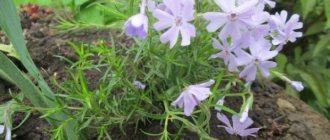Varieties with photos and names
The culture has many varieties, mostly all tall, perennial shrubs. The flowers differ in size and color. All have a five-petal shape. Another difference between varieties is flowering time. Otherwise, the cultivars are similar: they have the same requirements for agricultural technology, planting time, and methods of reproduction.
Early varieties of paniculata phlox
Early varieties of paniculata phlox include varieties that bloom from late June to mid-July. All of them have a long cycle (within 1.5 months). Their care is the same, but the attitude of the varieties to ultraviolet radiation is different.
Apple blossom
A medium-sized compact bush, peduncles 60-65 cm high. It grows quickly and gains green mass. The inflorescences are dense, the flowers are 4-5 cm in diameter, soft pink, the core is a shade darker. The culture prefers open areas.
Apple blossom is one of the earliest paniculate cultivars
Purple Haze
The height of paniculate phlox is 80-85 cm. The plant forms a spreading bush that holds its shape well and therefore does not require a garter. The inflorescences are large, conical, dense. The flowers are light lilac with a purple center. It blooms at the end of June, the cycle lasts 45 days.
In bright light the color is more saturated, in the shade it appears lighter
Storm
The variety grows up to 1.1 m in height, forms round inflorescences of medium density. The flowers are purple, not a single color; the edges of the petals and the core have purple inclusions. The paniculate culture retains its decorative color only in partial shade.
Important! In the open area, the color fades, the petals are baked along the edges.
Flowering time is long (within 1.5 months), the cycle begins in July
New varieties of paniculata phlox
Breeding work to create new varieties of paniculate phlox with a longer flowering period and colors unusual for the crop is ongoing. Several European novelties that interested designers and florists.
Blue Paradise
Phlox paniculata Blue Paradise is a cultivar with tall peduncles. The bush grows up to 1.2 m in height. The culture forms a wide crown, up to 80 cm in diameter. The inflorescences are dense, densely located, and have the shape of a cone. The flowers are medium-sized, blue-violet, evenly colored.
The flowering period begins in mid-July and lasts about two months
Hesperis
The new variety of paniculate phlox Hesperis is a tall variety, the length of the stems with inflorescences reaches 1.7 m. The shape and color of the inflorescences of the phlox resembles a lilac bush. The petals are dark pink, regular round in shape.
Late variety, the first buds open in the second ten days of August, flowering lasts 50 days
Gray Lady
Gray Lady (Sedaya Dama) is part of the group of smoky varieties of paniculate phlox. The flowers of the variety have a silvery coating, changing the basic dark pink color to various shades. It is difficult to find flowers of the same color in an inflorescence. The bush is dense, tall (up to 70 cm), the inflorescences are round and densely located.
Flowering of the Gray Lady variety is medium late, lasts from July to mid-September
Varieties of paniculata phlox with large flowers
In Phlox paniculata, flowers with a diameter greater than 4.5 cm are considered large. These varieties include: Anna German, Miss Kelly, Sandro Botticelli.
Miss Kelly
The paniculate variety Miss Kelly reaches a height of 1.2 m. The culture is characterized by high stem formation. The flowers are 5 cm in diameter and form a dense spherical inflorescence. The upper part of the bush is covered with flowers with round petals of soft pink color with white fragments at the base.
The flowering period of the Miss Kelly variety is quite long (from July to early September)
Anna German
The paniculate variety has bright salmon-colored petals with darker centers and white areas. The inflorescences are very dense, wide, cone-shaped. Flowering begins in July and lasts 1.5 months.
Variety Anna German medium-sized (up to 80 cm)
Sandro Botticelli
Sandro Botticelli - paniculate phlox of Russian selection. A variety with high decorative qualities is used not only in design, but also in floristry. A bush with straight stems grows up to 70 cm in height. The inflorescences are cone-shaped, formed not at the crown, but from the middle to the very top. Blooms from July.
The flowers of the Sandro Botticelli variety are lilac in color, reach 6 cm in diameter, and are prone to fading
Varieties of white paniculate phlox
White coloring is not typical for the culture; it is a rare variety of paniculate phlox, which does not retain its characteristics during generative propagation. The most popular varieties include: Zephyr, Snow White, Swan Princess.
Marshmallow
The Zefir cultivar is a low-growing herbaceous shrub 65-70 cm high. It blooms from July to September with large rounded inflorescences. The petals are white with pink fragments at the base.
The more acidic the soil composition, the more pink the color of Zephyr petals
Swan Princess
A variety with pure white flowers and a beige core. Petals with pointed tips, star-shaped flower with a diameter of 5 cm. The plant is not tall - 60-65 cm, but with a very thick crown and dense inflorescences.
The buds of the Swan Princess open one by one
Flowering occurs in June.
Snow White
The paniculate variety blooms with white flowers with a yellow core. The inflorescences are so dense and heavy that they bend the stems, so the plant requires staking from July to the end of August.
The height of the Snow White variety is 75-80 cm
Perennial paniculate phlox
Almost all plant varieties are perennial. The rarest and most popular cultivars include the following: Egorka, Success, Bambini Candy Crush.
Egorka
The variety is small-flowered, diameter – 2-2.5 cm. The shape is star-shaped, the color is uneven: the middle and base of the petals are light purple, the edges have a beige-pink tint. The plant is medium-sized – 80 cm. The inflorescences are cone-shaped, very dense, a rare variety, highly decorative.
Egorka blooms for 2 months, starting in June
Success
The perennial cultivar Uspech is 75-85 cm high, characterized by a dense crown and stable stems. The color of the petals is interesting; they are dark purple, with a contrasting white center.
The first buds open in July, the cycle lasts 45 days
Bambini Candy Crush
Highly decorative cultivar Bambini Candy Cruz from Holland is a rare, frost-resistant variety of paniculate phlox. One of the shortest representatives (height 55 cm). The inflorescences are round, compact, formed by large flowers with white and carmine colors.
Bambini Candy Crush flowering period – July-August
Paniculate phlox with red flowers
The most common perennial variety has bright red petals of varying shades. The following varieties are popular among gardeners: Margarita, Miss Mary, Starfire.
Miss Mary
The Miss Mary cultivar, 75-80 cm high, is a compact, dense bush with strong stems that do not require staking. The inflorescences are cone-shaped and lush. The flowers are bright crimson with burgundy fragments at the base. The petals resemble velvet.
The buds bloom in July; the Miss Mary bush retains its inflorescences until the end of August
Margarita
Margarita is one of the brightest representatives of the red paniculate phlox group. The height of the plant is 1.2 m, the diameter of the flowers is 4.5-5 cm, the width of the cone-shaped inflorescences is 25 cm. The petals are pale burgundy with a purple spot at the base.
Margarita is a late variety, the last buds bloom in October
Starfire
The Starfire paniculate phlox group is represented by several cultivars with different variations of red. The classic variety reaches a height of 1 m, has rounded inflorescences formed by bright crimson flowers. Flowering is early, begins in June.
A special feature of the Starfire variety is the concave edges of the petals in the shape of a bowl.
Paniculate phlox with exotic colors
The varieties are rare; they are propagated only vegetatively. Due to their unusual colors, cultivars will decorate any composition:
- Orange Perfection (Orange perfection) height – 75 cm, large-flowered, buds open in July, cycle lasts 2 months. The color is orange with a bright spot by src=»https://agrognom.ru/wp-content/uploads/2020/02/19-2.jpg» class=»aligncenter» width=»624″ height=»529″[/ img] Variety Orange Perfection suitable for cutting
- Sherbet Blend is a rare cultivar with green petals and a bright purple spot at the base. The height of the perennial is 70 cm, the flowers are of medium size, forming round inflorescences. The variety is early, the buds open in June.
With sufficient lighting, the ends of the petals turn lemon-colored. - Gzhel is a variety of Russian selection with large flowers, the petals have one half purple, the other white, the core is burgundy, an early variety.
The height of the Gzhel phlox bush is 90 cm - Dragon belongs to the group of smoky phloxes. This variety is over 60 years old. It is difficult to clearly determine the color; the flowers are variegated. The height of the perennial is 95 cm.
Flowering of the Dragon is mid-early, the duration of the period is 40 days
Phlox divaricata
Phlox spreada is native to North America and is often called Phlox canadensis. Other names for this plant are forest phlox or wild blue phlox.
This is a medium-sized plant that is very different from the previous two types of phlox. The height of the splayed phlox is 20-50 cm. The color scheme of the petals is bluish-lilac, in delicate pastel colors.
This phlox loves well-fertilized soil, but at the same time is perfect for rockeries and rocky areas. It also has a strong sweet aroma and attracts many bees and butterflies.
Not many varieties of this perennial are grown in cultivation, but all of them are 100% worth the time and effort invested in caring for them.
Clouds of Perfume
Phlox Clouds of Perfume forms a turf up to 60 cm wide. In spring, it is dotted with a scattering of charming lavender flowers that fill the flower garden with their aroma.
Please note that this phlox is not resistant to powdery mildew and nematodes.
| Petal coloring | Bush height (cm) | Bush width (cm) | Flowering time |
| Lavender | 20-30 | 50-60 | April May |
Landen Grove (London Grove)
From a distance, the Landen Grove phlox bushes can be mistaken for a sea of forget-me-nots. But if you come a little closer, you will be covered with a cloud of subtle aroma that cannot be confused with anything else.
This perennial is quite resistant to powdery mildew, grows well and does not require special care.
| Petal coloring | Bush height (cm) | Bush width (cm) | Flowering time |
| Bluish-lavender | 30-35 | 50-60 | April May |
Fuller's White
White bushes of Fullers White will be an excellent decoration for a spring mixborder.
This phlox is notable for its excellent winter hardiness - it can withstand frosts down to –40°C.
| Petal coloring | Bush height (cm) | Bush width (cm) | Flowering time |
| White with a slight purple tint | 30-35 | 15-30 | April May |
Eco Texas Purple
Phlox Eco Texas Purple is notable for its spectacular dark lilac flowers. It differs from most spreading phlox cultivars in its later flowering period - from late spring to early summer.
| Petal coloring | Bush height (cm) | Bush width (cm) | Flowering time |
| Purple with pink eye | 30-35 | 15-30 | May June |
Phlox paniculata in landscape design + photo
All varieties of paniculate phlox are tall plants, the stems are rigid and stable, the bushes hold their shape well and do not fall apart, so the plant can be planted in any open corner of the garden.
Phlox paniculata is combined with flowering crops of the same height, for example, irises, daylilies, and dahlias.
Advice! It is necessary to choose a color scheme; plants with dark, bright inflorescences are best placed with white, yellow or light pink.
Paniculate phloxes serve as an ideal lining for large conifers or ornamental shrubs. They harmonize well with the dwarf forms of phlox, acting as a central accent in the flowerbed. They look harmonious in a group planting with peonies.
Several examples of the use of crop varieties in the design of a plot or garden:
- They decorate flower beds, creating compositions based on the contrast of flower colors.
Mixborder of daylily and various paniculate varieties - They create improvised hedges.
- Used in a single planting to decorate an empty area.
- Included in compositions with ornamental crops.
- Varieties are planted along the perimeter of fences.
- Planted along garden paths.
Botanical description of the species
Phlox paniculata is a perennial herbaceous plant 35-150 cm tall. Most varieties form bushes 60-70 or 80-100 cm high. It must be remembered that this parameter changes depending on the light intensity. In bright sun the plants turn out lower, but even two hours of midday shading increases their height. The stems are very strong, straight, and become woody towards the end of the growing season.
There is no yellow in the color palette of paniculata phlox. This pigment is also absent in the group of so-called red varieties. Their color is dominated by crimson color of varying saturation of both warm and cold tones. Therefore, in the descriptions there are such definitions as red-pink, red-lilac, light orange-red, purple-red, etc. The situation is similar in the orange or salmon group. These tones are very unique and complex, they also come in varying intensities with the addition of pink and carmine.
Growing paniculata phlox from seeds
If there are no phlox plants in the garden to collect seeds, purchase planting material. You can sow paniculate phlox directly into the ground and create a greenhouse effect for it. When the seedlings rise by about 5 cm, they are placed at the planting site.
Seedlings are grown from seeds at the end of the growing season.
Attention! This method is more suitable for regions with cold winters.
Phlox paniculata can be grown by planting seeds:
- They are soaked and placed in a damp cloth in the refrigerator.
- Nutrient soil is poured into shallow containers; it can be purchased ready-made or mixed independently from compost and peat.
- Make shallow longitudinal furrows and sow seeds, cover with soil, and moisten abundantly.
- The top of the container is covered with film.
- After the sprouts appear, the covering material is removed and the plants are watered with nitrogen-containing agents.
- When the seedlings reach 15 cm in height, they are planted into separate glasses.
Leave it indoors and water it periodically.
Advice! 2 weeks before planting, seedlings of paniculate phlox are taken to an open area for hardening.
When there is no threat of night frosts, leave them outdoors for 2 days, then plant them.
Planting and care
Phlox paniculata is not a fastidious plant. They can develop on any soil composition, but a fully decorative appearance is possible only on a neutral soil composition; slightly acidic soil is allowed. If the soil is poor, it can be corrected by feeding the plant and planting it in a fertile substrate.
The culture is light-loving, but responds quite calmly to periodic shading. It is not recommended to allocate space for paniculata varieties under large trees, on the north side, behind the wall of buildings and in a draft.
Important! For paniculate phlox, a place with stagnant water is unacceptable.
For planting, choose material with a healthy root system. The exposed root is placed in a growth stimulator and antifungal agent for the time specified in the instructions.
Sequence of planting work:
- 7 days before the procedure, dig a hole 30 cm deep and wide.
- The bottom is covered with drainage and fertile soil consisting of compost, sand, turf layer with the addition of complex mineral fertilizer.
- The recess is filled with water.
- On the day of planting, the substrate is slightly loosened so that it is enriched with oxygen.
- They place the seedling according to src=”https://agrognom.ru/wp-content/uploads/2020/02/30.png” class=”aligncenter” width=”603″ height=”385″[/img]
- The root collar is deepened by 2-3 cm.
- The soil around the bush is compacted and watered.
Important! If work is carried out in the fall, the stems are cut so that no more than 10 cm remains above the surface.
After placing paniculate phlox in its place of growth in the spring, the stems are not shortened
Preparing the landing site
When choosing and preparing a place for paniculate phlox, you should remember that this flower prefers well-fertilized, fertile soils and abundant watering, but does not tolerate stagnant moisture. When working with a plant such as paniculata phlox, planting is not difficult. It is only important to remember that they develop and bloom poorly on the north side, in areas blown by prevailing winds, on slopes, as well as under the crowns of various conifers and trees with a shallow root system, such as birch, lilac, various varieties of willow and poplar.
Phlox paniculata can be planted in poor soils, in partial shade and in the sun. You just need to remember that many dark-colored varieties can fade, and plants growing on uncultivated soils are unlikely to delight you with beautiful and rich flowering.
Features of cultivation
The main care for paniculate phlox consists of watering and fertilizing. Fertilizers are applied during the spring-autumn period:
- at the beginning of the season, products with nitrogen and phosphorus are relevant;
- at the time of budding, liquid organic matter and ammonium nitrate are added;
- During flowering, superphosphate is recommended.
The watering regime is oriented according to seasonal precipitation; paniculate phlox should receive moisture 2 times a week. By autumn, the frequency of watering is reduced, especially before the temperature drops.
Phlox is watered at the root and with an aerosol method at any stage of development, the flowers are not afraid of moisture
If after planting the root circle is covered with mulch, there is no need for loosening, the material prevents the formation of compaction on the soil.
Weeds are removed regularly if they grow next to or under a bush. This measure is aesthetic and preventive in nature. In frequent cases, weeds become the cause of fungal infections.
Protection from diseases and pests
The immunity of paniculate phlox varieties is average; the plant can become infected with temperature fluctuations or lack of nutrition:
- powdery mildew;
- leaf rust;
- variegation.
All diseases are fungal in nature. For preventive purposes, the soil around the plant and the above-ground part is treated with any antifungal agent. If paniculate phloxes show signs of infection, they are sprayed with Ridomil Gold.
The main damage to the plant is caused by the slobbering pennies. To combat the pest, “Commander” is used.
Treatment is carried out twice, maintaining an interval of 14 days.
The appearance of nematodes is less common. In this case, it will not be possible to save the plant; it, along with the roots, will be removed from the site.
Preparing paniculate phlox for winter
Cultivars of paniculate phlox are highly frost-resistant. With proper preparation for winter, an adult plant can withstand up to -35 0C.
Autumn events:
- After the leaves turn yellow and begin to fall off, the flower stalks are removed.
All stems are cut at the root at a height of no more than 10 cm - Potassium and organic fertilizers are applied.
- Cover the tree trunk circle with a layer of mulch (5-7 cm). For the south, these events are enough.
- In regions with low temperatures, spruce branches are placed on top or a structure is made from arcs, and covering material is pulled over it.
Important! If the seedlings are covered with film, it must be removed in early spring so that the roots do not trample.
Reproduction methods
Most varieties of paniculate phlox produce seeds that, once planted, retain the external characteristics of the parent plant, so the crop can be propagated generatively. But more often they use the vegetative method. The most productive way is to divide the mother bush. A plant aged 2-3 years with a strong aerial part is suitable for this purpose. After flowering, the bush is divided into several parts and placed on the site.
On each plot leave 2-3 stems and a well-developed part of the root
The varieties can be propagated by layering. In spring, the lower stem is covered with soil, and roots form on it around August. The cuttings are cut into pieces and planted in a designated place; the young plant is well insulated for the winter.
Select a strong stem and fix it to the ground using metal staples
The cutting method is suitable for culture. The material is harvested in May from the upper part of the stems 10-15 cm long. They are placed in a container with water, when the root threads appear, they are determined by the area.
After harvesting, all lower leaves are removed, the crown is cut off, the remaining leaf plates are shortened by a third
What should you know about phlox propagation?
Speaking about ways to promote the reproduction of these flowers, we can highlight several. The simplest and most convenient method of propagation is by dividing the bush. It should be used in spring and early autumn. It consists in the fact that the bush must be divided into parts consisting of several thick and strong stems.
It is advisable to propagate the plant using cuttings in the first half of summer. The most suitable month for this purpose is June. At this time of year there is no flowering period yet. It will be easy for young cuttings to take root. After a month they can be transplanted to a permanent place.
Another popular method is propagation by layering. With it, the stems are attached to the soil and are thoroughly hilled using a mixture that includes humus and peat. By the onset of autumn, it will be possible to find independent plants growing from such stems.
You can grow paniculata phlox using purchased seeds for this purpose. Preference should be given to stratified seeds. It is advisable to plant them in a box or pot. Over time, it will be necessary to pick several times so that the plants do not stretch too much. After which the phlox can be transplanted into a greenhouse. Transplanting plants into open ground conditions is possible in the first weeks of May.











